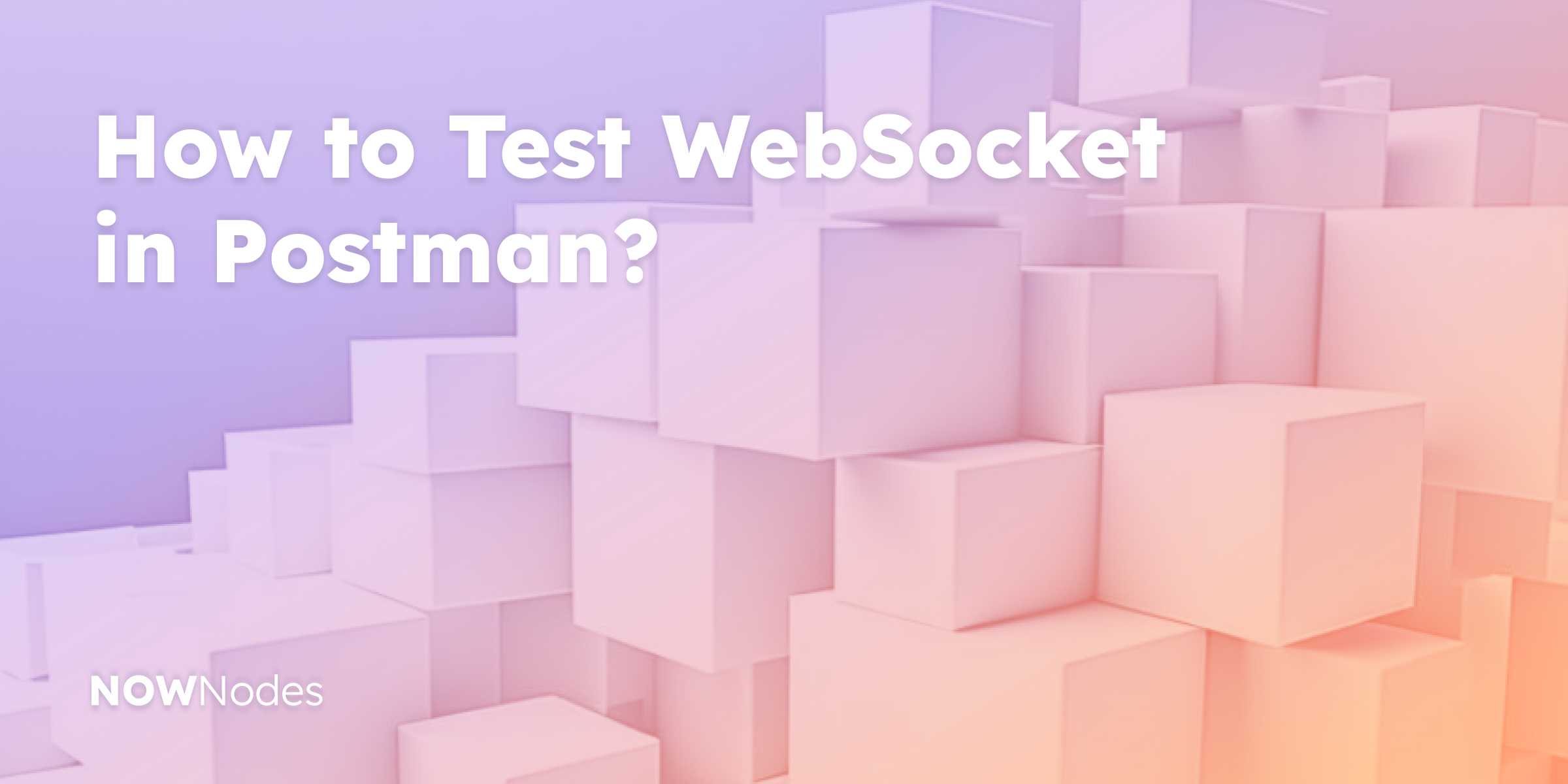WebSocket testing has become an essential part of modern Web3 development. It allows developers to test real-time communication between clients and servers, enabling interactive and dynamic web applications. With NOWNodes, you can easily create WebSockets subscriptions to blockchain networks and test a WebSocket connection.
In this article, we will explore how to unleash the power of Postman for WebSocket testing.
Understanding the benefits of Postman WebSocket testing
Postman is widely known as a popular API testing tool, but it also provides excellent support for WebSocket testing. Here are some key benefits of using Postman for WebSocket testing:
- User-friendly interface: Postman offers an intuitive interface that allows you to easily create and manage WebSocket requests. You can organize your requests and collections, making it convenient to test different scenarios.
- Request customization: Postman allows you to customize your WebSocket requests by adding headers, query parameters, and request bodies. This flexibility enables you to simulate various scenarios and test different aspects of your WebSocket implementation.
- Automation capabilities: Postman provides powerful automation capabilities through its scripting feature. You can write scripts in JavaScript to automate your WebSocket testing workflow, allowing you to perform complex testing scenarios and validations.
By using Postman, you can streamline and simplify the WebSocket testing process, saving time and effort. Now, let’s dive into the steps of how to test Websockets.
Steps to Postman WebSockets testing
Before you can start testing WebSockets with Postman, you need to get your WebSocket API Key.
A WebSocket API is a communication protocol that allows real-time, bidirectional communication between a client and a server. The WebSocket endpoint is the URL where the WebSocket connection is established, typically starting with “ws://” or “wss://“.
Let’s find out how to get an API key for a Postman WebSocket test.
Get Started Utilizing WSS Endpoints with the API Key
Before you send a request, download and install Postman from the official website or use its web version. Moreover, to get started testing WSS in Postman, you have to get an API key that allows you access to the WSS endpoints and set up a WebSocket connection.
NOWNodes is a reliable blockchain-as-a-service platform that allows you to establish websocket connections by providing private API keys. Moreover, the service offers a scalable infrastructure that can handle high traffic of request volumes with 99,95% uptime, making it suitable for applications that require large amounts of real-time data.
Here’s a step-by-step guide for getting started:
- Create a NOWNodes account: Visit the NOWNodes website and create an account.
- Generate an API key: Once you have created an account, generate an API key in the NOWNodes dashboard. This API key will be used to authenticate your requests when connecting to the many WebSocket APIs available. Important! you cannot test WebSocket with free plan!
- Import the NOWNodes documentation: NOWNodes provides a predefined documentation that includes all the necessary API endpoints. Find the collection file on the NOWNodes website
- Configure the NOWNodes environment: In Postman, create a new workspace to use for the API requests to establish the websocket connection.
- Test the websocket connection: Use the provided NOWNodes API endpoints in Postman to test the websocket connection with the use of the methods provided by NOWNodes.
Below you can find exact websocket endpoints provided by NOWNodes which you can utilize for your requests:
- btc.nownodes.io/wss
- eth.nownodes.io/wss
- ethw.nownodes.io/wss
- bsc.nownodes.io/wss
- doge.nownodes.io/wss
- ltc.nownodes.io/wss
- dash.nownodes.io/wss
- dot.nownodes.io/wss
- bch.nownodes.io/wss
- zec.nownodes.io/wss
- avax.nownodes.io/wss
- matic.nownodes.io/wss
- atom.nownodes.io/wss
- zetachain-tendermint.nownodes.io/wss
- lunc-fcd.nownodes.io/wss
- optimism.nownodes.io/wss
- arb-blockbook.nownodes.io/wss
- inj.nownodes.io/wss
- pulse.nownodes.io/wss
- qtum.nownodes.io/wss
- qtum-blockbook.nownodes.io/wss
- bera.nownodes.io/wss
- xrp.nownodes.io/wss
- base.nownodes.io/wss
By following these steps, you will have successfully set up the NOWNodes WebSocket API in Postman for any WSS endpoint you’ve chosen.
Now you are ready to utilize all the available NOWNodes methods in the Postman and interact with your platform by using the available WebSocket endpoints.
So let’s find out how to send WebSocket requests with Postman.
Common instructions for sending Postman WebSocket requests
Once you have set up Postman and got your API key for WebSocket testing, you can start sending WebSocket requests.
Follow these steps to send a WebSocket request using Postman:
- Follow the Postman interface: find the “NEXT” or “+“.
- Select the request type: In the new tab, find the request type switcher and choose the “WebSocket” option from the drop-down menu next to the URL input field.
- Enter the WebSocket URL: Specify the WebSocket URL in the URL input field. Make sure to include the “
ws://” or “wss://” protocol prefix, followed by the host and port. For example, NOWNodes provides “wss://:” protocol prefixes, that you can find on the “NODES” page. - Customize the request: If needed, you can customize the WebSocket request by adding headers, query parameters, or request bodies. This allows you to simulate different scenarios and test specific aspects of your WebSocket implementation.
- Send the request: Click the “SEND” button to send the WebSocket request. Postman will establish a WebSocket connection and display the response in the response panel. You can analyze the response and verify that your WebSocket implementation is working as expected.
Configuring WebSocket Connections in Postman
Postman provides various options to configure WebSocket connections and handle different scenarios. Here are some advanced techniques for configuring WebSocket connections in Postman:
- Authentication: If your WebSocket server requires authentication, you can include authentication headers in your request. Postman allows you to set custom headers and authenticate your WebSocket requests accordingly.
- SSL/TLS support: Postman supports SSL/TLS connections for secure WebSocket testing. You can specify the “
wss://” protocol prefix and configure any necessary SSL/TLS settings to establish a secure connection. - Connection timeouts: In some cases, you may want to set a specific timeout for your WebSocket connections. Postman allows you to configure connection timeouts to ensure that your requests do not hang indefinitely.
Remember to refer to the WebSocket API documentation to understand the specific protocols, message formats, and authentication requirements for your connection.
Now as you know common issues that allow you to test websockets in Postman, we are going to show you examples of Postman testing with NOWNodes.
Best Examples of Postman WSS Testing Through API With NOWNodes
By leveraging the capabilities of NOWNodes, a leading provider of blockchain API services, we will demonstrate how Postman can be used to test and validate various API endpoints, making it an invaluable tool for developers in the blockchain space.
We are going to explore and test the Ethereum WebSocket connection.
Ethereum WebSocket API Connection
To test the Ethereum WebSocket response in Postman, you can follow these steps. User should change request type from HTTP to WebSocket . For example, if you are using NOWNodes, the URL would be:
wss://eth.nownodes.io/your_api_key
Go to the “Headers” tab and add a new header with the key “Content-Type” and value “application/json“.
Go to the “Message” tab and enter the JSON payload for the WebSocket request. For example, to subscribe to new block headers, you can use the following payload:
{
"jsonrpc": "2.0",
"id": 1,
"method": "eth_subscribe",
"params": ["newHeads"]
}After that clilck to the “Connect” bottom and then click on the “Send” button to forward the WebSocket request.
Postman will establish a WebSocket connection and display the response in the “Response” panel. The response will contain the data you subscribed to, such as new block headers in the case of the example payload above.
Conclusion
Postman is an incredibly powerful tool for testing WebSockets. Its user-friendly interface, customization options, and automation capabilities make it a valuable asset for any developer working with WebSocket connection.
By following the techniques and best practices outlined in this article, you can unleash the power of Postman and streamline your WebSocket testing process. So, get access to WebSockets and leverage the advanced and safest technologies for your crypto business with NOWNodes.



